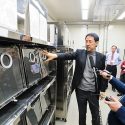Flu-infected fly cells reveal dependencies of the virus
By giving fly cells the flu, scientists have identified scores of host genes the pathogen requires for successful infection, revealing a raft of potential new pressure points to thwart the virus.
Writing in this week’s issue of the journal Nature, a team of researchers led by Yoshihiro Kawaoka and Paul Ahlquist of the University of Wisconsin–Madison describe experiments testing the ability of a modified flu virus to infect cells whose genes were systematically disabled to see which were co-opted by the virus.
The new study is important because it demonstrates a rapid-fire technique for identifying host factors such as proteins and carbohydrates that a virus commandeers to successfully infect a cell. By exposing the virus’s dependencies, the Wisconsin team has uncovered a target-rich environment for influenza drug developers.
Although the work was done in cells of the redoubtable fruit fly model Drosophila melanogaster, most of the genes have mammalian analogs and initial tests in human cells of three of the 100 genes identified confirmed that all three are necessary for the virus to successfully make copies of itself to promote infection.
“The genes we identified in mammalian cells are very specific for influenza viruses,” says Kawaoka, a professor of pathobiological sciences at the UW–Madison School of Veterinary Medicine and a renowned flu expert. “Now we know influenza viruses are using specific host proteins so those become targets for drug development.”
All viruses depend on host cells to provide the resources that enable successful infection. “Viral infection is like classic guerilla warfare. A major source of the virus’s resources is the enemy — the host cell,” explains Ahlquist, a Howard Hughes Medical Institute investigator at UW–Madison. “All the steps in viral infection require host factors. The question is what are they and what do they do?”
By working in fly cells, the Wisconsin team was able to deploy a technique to rapidly and selectively silence thousands of genes to see which were used by the flu virus. Screening a library of some 13,000 genes, the group identified more than 100 whose suppression in fly cells hindered the virus’s ability to successfully take over the cell and make new viruses.
To assess relevance to human cells, the group disabled three genes in human cells that corresponded to key genes found in the fly cell screen and discovered that strains of avian flu, including the worrisome H5N1 strain, needed all of those genes to successfully reproduce.
“All of the evidence is that this is a high-value set of genes for testing in mammalian cells,” says Ahlquist. “It has implications for virology and control.”
The new study reveals a powerful new way to search for antiviral pressure points. In the case of influenza, the need for new antiviral drugs is acute as there are only a few and they are considered a first line of defense against pandemic flu. There is also gathering evidence that virulent flu strains such as H5N1 are developing resistance to the drugs that are currently available.
The new Wisconsin study involved modifying a flu virus by adding a protein borrowed from a virus that normally infects flies, something ordinary flu is unable to do. “We changed the surface of the virus so it could bind to the surface of a drosophila cell and get in,” Kawaoka explains, noting that the altered virus is unable to complete its life cycle in the fly cell. “The virus does not get out of the cell.”
Both Ahlquist and Kawaoka say that the new system has potential application beyond studies of influenza and could help speed the development of antiviral drugs for many diseases, including AIDS.
Other authors of the new study include Linhui Hao, Akira Sakurai, Tokiko Watanabe, Ericka Sorensen and Michael A. Newton, all of UW–Madison; and Chairul A. Nidom of the Tropical Diseases Center, Airlangga University, Indonesia. The research was funded by grants from the U.S. National Institutes of Health and the Japanese Ministry of Education, Culture, Sports, Science and Technology.


